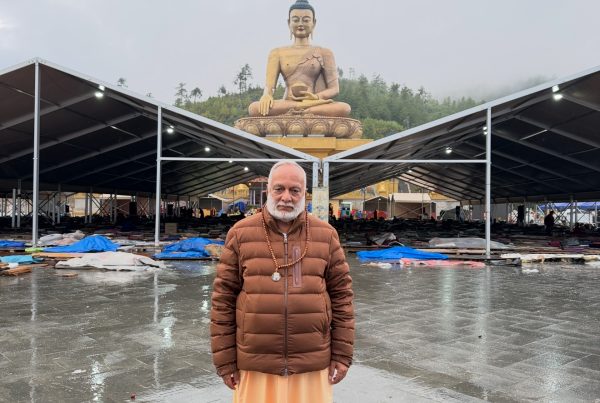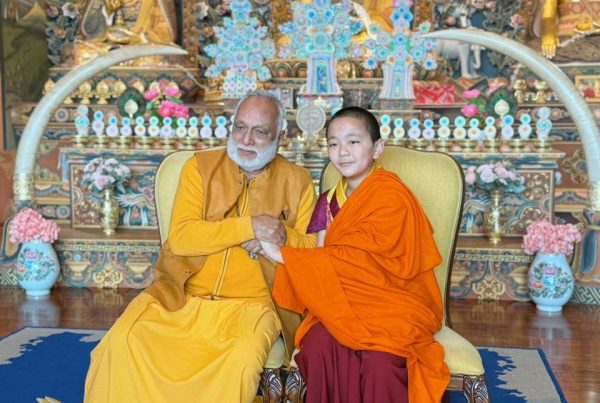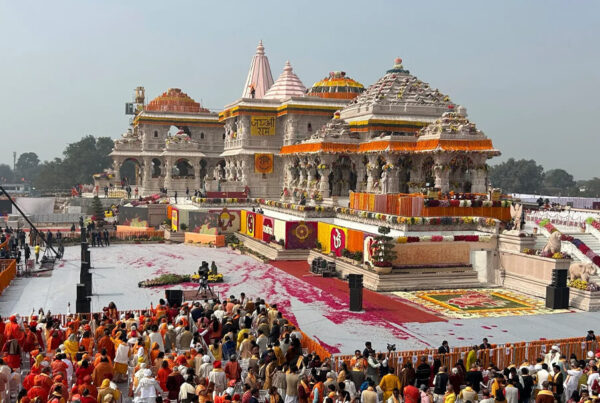
Buddha and the transformation of Queen Chhyama and Patachara
Buddha is such a pragmatist that even atheists find refuge in his teaching. His teaching is so scientific and accurate that it has withstood the test of time, and continues to illuminate the path of millions of seekers all over the world.

Twenty-five centuries ago, King Suddhodhan reigned over a fertile plain in the foothills of the Himalayas, which now falls in modern-day Nepal. The land, succulent with lush green vegetation, was inhabited mostly by the Shakyas. One beautiful summer afternoon, Queen Maya, the wife of Suddhodhan, retired to her chamber for her afternoon siesta. The fragrant air, spiced with sweet fruits and flowers, soon lulled her into sleep. The queen woke up to the vivid memory of a dream she had just had. In her dream, a white elephant with a blossoming white lotus in its trunk circumambulated her three times, struck her on the right side and vanished. The queen related the dream to her husband, who invited sixty-four Brahmins to interpret the dream. They all unanimously predicted the birth of an extraordinary child, who would either be a great emperor or an enlightened one.

As the birthing date neared, the queen expressed her desire to give birth in her childhood home at Devadaha, a royal procession left Kapilvastu, the capital city of the kingdom, for Devadaha. On the way they arrived at Lumbini grove. The grove was full of trees laden with beautiful flowers, and the joyous spring mood permeated the orchard. The queen alighted from her chair, and walked through the garden to touch a blossom. As she walked towards the flower, she was suddenly seized by the convulsions of labour pains, and gave birth to Siddhartha Gautam, the prophesied prince. On the same full-moon night, princess Yashodhara, his wife-to-be, was also born in a palace of the Koili dynasty at Devdaha. Thirty-five years later, Siddhartha Gautam attained enlightenment on the same full-moon night and became Buddha. He left his body at the age of eighty on that very day. This full moon of spring, known as Baisakh Purnima, is celebrated as Buddha Jayanti all over the world. Buddha heralded a new age. His teaching was based on understanding, logic and contemplation, and left little room for superstition. During his time, Hinduism was rife with traditions and superstitions, which had long lost their relevance. The prevalent priests used these rituals as a means to impose a false authority over people. With Buddha, religion matured. For the first time, religion became free from prayer, rituals and superstitions. His teaching awakened spiritual thirst in the hearts of many young men and women that followed his path.
Buddha is such a pragmatist that even atheists find refuge in his teaching. Nietzsche, who famously declared God is dead, couldn’t deny the obvious truth in Buddha’s word. He praised Buddhism for setting out to treat ‘suffering’ as opposed to ‘sin’ as the primary point of all religious quest.
Buddhism is best described in the words of Einstein, who was thoroughly inspired by Buddha. “Buddhism has the characteristics of what would be expected in a cosmic religion for the future: It transcends a personal God, avoids dogmas and theology; it covers both the natural and the spiritual, and it is based on a religious sense aspiring from the experience of all things, natural and spiritual, as a meaningful unity.” Buddha said, “Sabbe sankhara anichchati — Nothing is permanent in this world, everything is in constant flux.”
This includes relations, position, wealth, health and even life itself. This is why to be attached to anything here is to give birth to sorrow. If we can accept this philosophy of impermanence then we can be free from attachment and anxiety, opening up the path for peace and contentment. Buddha based his argument on impermanence, and refused the idea of an eternal God. He also refused the existence of the soul. According to Buddha, the soul does not reincarnate, rather it is desire that changes its form and is born again and again. When all desires cease, one achieves nirvana or ultimate emancipation. Buddha preached that this world is the manifestation of sorrow, and until and unless we are free from desire, we will keep getting entangled in various webs of grief. All have to go through the pain of disease, sorrow and death. Every love results in separation, each admiration in bitterness, and each victory in defeat.
During Buddha’s time it was common belief that to attain success in anything, one had to appease the gods. Animal sacrifice was a common sight. Some even resorted to human sacrifice as a means of pleasing the gods. This sado-masochistic approach is not uncommon in many religions. Buddha discarded these beliefs. He said, “No deity can either do good or bad to you. Your own actions lead to happiness or sorrow. Ata hi atano nathaata hi atano gati — you are the creator of your destiny and you are the sole reason for your rise or fall.”
Buddha preached the middle path — neither indulgence, nor renunciation, but a balanced and aware living. According to the eight-fold path, awareness and balance in all aspects of life is the key to meditation: right view, right intention, right speech, right action, right livelihood, right effort, right mindfulness and right enlightenment. The mind thrives on extremities. As soon as one refuses to relent to either extreme, one is released from the clutch of the mind, giving birth to a calmness and equanimity within. Buddha’s teaching is so scientific and accurate that it has withstood the test of time, and continues to illuminate the path of millions of seekers all over the world.
The Transformation Of Queen Chhyama
The Magadh Emperor, Bimbasar, was married to Chhyama, the princess of Syalkot. (Syalkot today is in Pakistan). Chhyama was extremely beautiful and proud of her beauty.
Bimbasar was a devotee of Buddha. Whenever Buddha was in Rajgriha, the capital of Magadh, the whole royal family would come and pay their respects to him. Chhyama, however, was too proud of her beauty and youth and never joined the king on his visits. One day, Buddha was walking in the Benuvan forest, at Rajgriha. Queen Chhyama had also gone for a walk there. King Bimbasar sent her a message that she should not return to her palace without having the darshan of Buddha. Rather reluctantly, she went to see Buddha. Buddha greeted Chhyama tenderly and yet she saw no desire arise in his eyes. She could see that her beauty and charm did not affect Buddha in any way. He remained serene and equanimous. Chhyama was aware of her beauty and how it inspired lust and awe in each man she ever met. Buddha alone received her with equanimity.
This enraged the queen and she set out to leave angrily. Buddha read her mind and immediately created two beautiful women on either side of him using his siddhi. These women were by far more beautiful than Chhyama. This sight infuriated her still more. However, gradually those divine looking women started to age right in front of her. They became sickly and old, their beautiful teeth fell apart, the dark cascading tresses thinned and became grey wisps of hair, and their supple skin soon wrinkled into ugly flesh. Eventually, death came and both dropped dead by Buddha’s side. The carcasses were a wretched and horrid sight to behold. Chhyama was horror- struck by the sight. She instantly realized the impermanence of the world and the transience of beauty. She fell at the feet of Buddha, begged for his forgiveness and asked if she could be initiated. Buddha transformed her without uttering a word. Chhyama achieved the state of shrotapanna and became an ideal bhikkhuni.
The Woes Of Patachara
A rich merchant from Shrawasti had a very beautiful daughter named Patachara. Many young men were attracted to her beauty. Her parents used to lock her up in the upper chambers of their house so that no man may lay his eyes on her.
Patachara, however, fell in love with a servant of the household. The merchant had found a rich young fellow to be wed to Patachara, but on her wedding night she ran away with her lover. They fled from their village and made a simple living by doing menial labour. Patachara became pregnant and she left for her parents’ house with her husband to deliver her child, as they did not have proper arrangements for the delivery of the baby. However, she gave birth to the child on the way, so they returned home.
Patachara became pregnant again. They again left for Patachara’s parents’ home to deliver her second child. They had to travel through a dense forest to reach her maternal home. On the way, a great storm broke out. Patachara started to have labour pains. Her husband went in search of firewood. While he was chopping firewood, a poisonous snake bit him and he died right there.
Patachara gave birth to another child in the desolate forest. She spent the whole night protecting her children and waiting for her husband. In the morning she searched for her husband and found him dead. Grief-stricken, she started walking towards her parents’ home with her children. On the way there was a river that was swollen due to the monsoon rains, and it was impossible for her to cross the raging river carrying both her children. So she left her older child on the bank, and crossed the river with her newborn. Once she crossed the river, she left her infant there and went back to fetch her older child. When she was in the middle of the river, an eagle swooped down, grabbed Patachara’s newborn and flew away. Seeing this she started to panic and scream. Hearing his mother scream, Patachara’s older son thought that she was calling him, so he jumped into the river. The river took Patachara’s older child and drowned him. Having lost both her children and husband on the same day, she lost her mental balance and started to cry in deep agony.
As she neared the home of her parents, she met a traveller from the village. Patachara introduced herself and asked about her relatives. The man was dumbstruck after he heard her story. After much pleading he told Patachara how the previous night’s downpour had destroyed her parents’ house. Her entire family had drowned in the flood. “They were being taken to the burning ghat when I was leaving. The smoke that you see coming from the west is probably from their funeral pyre,” he told her.
This last tragedy totally broke her heart. She roamed naked around Srawasti wailing like a wounded animal. One day she arrived at Chetwan. The bhikkhus did not let her go near Buddha. Hearing her wailing, Buddha came out of the Gandhakuti, went near her and said, “Sister, come to your senses!”
As soon as she was in the peaceful presence of Buddha, she realized that she was naked. She sat down to cover herself. Buddha gave her one of his robes. She wore the robe, and lying prostrate at the feet of Buddha, narrated her tragic story. In the presence of Buddha, all her agony simply evaporated. A new calmness and peace descended upon her. Buddha said, “Just as you are shedding tears for your children and family now, you have shed tears in countless lives. The amount of tears humanity has shed for being separated from their loved ones is greater than the amount of water in the seven seas. Death and separation are the harsh rules of this world. Don’t destroy your body in mourning; rather find out the way to be free from the bondage of sorrow.”
Hearing these words of Buddha, Patachara achieved the state of shrotapanna right there. She then took initiation from Buddha and became a member of the Buddha sangha, and eventually became enlightened before she left her body.


